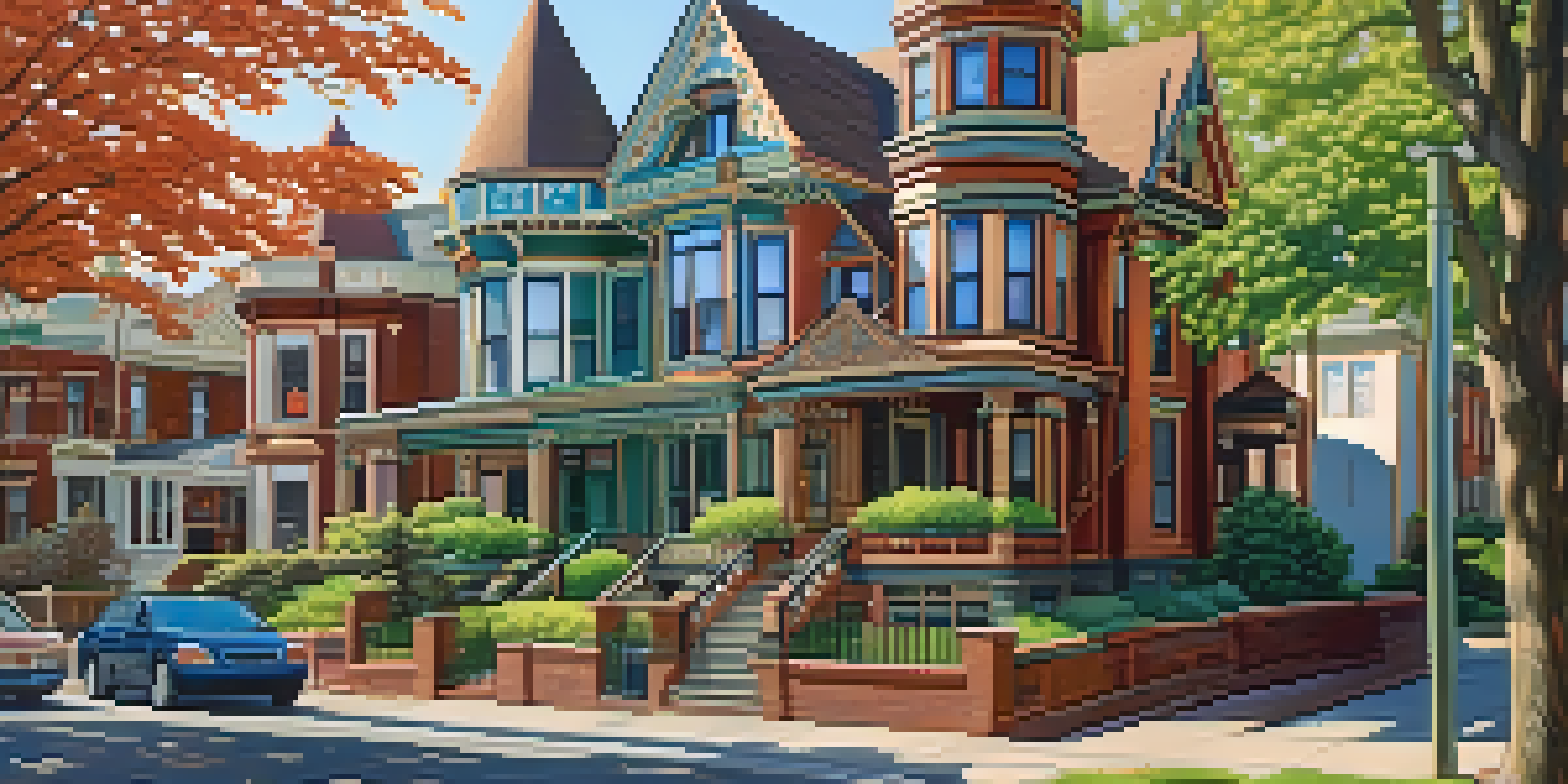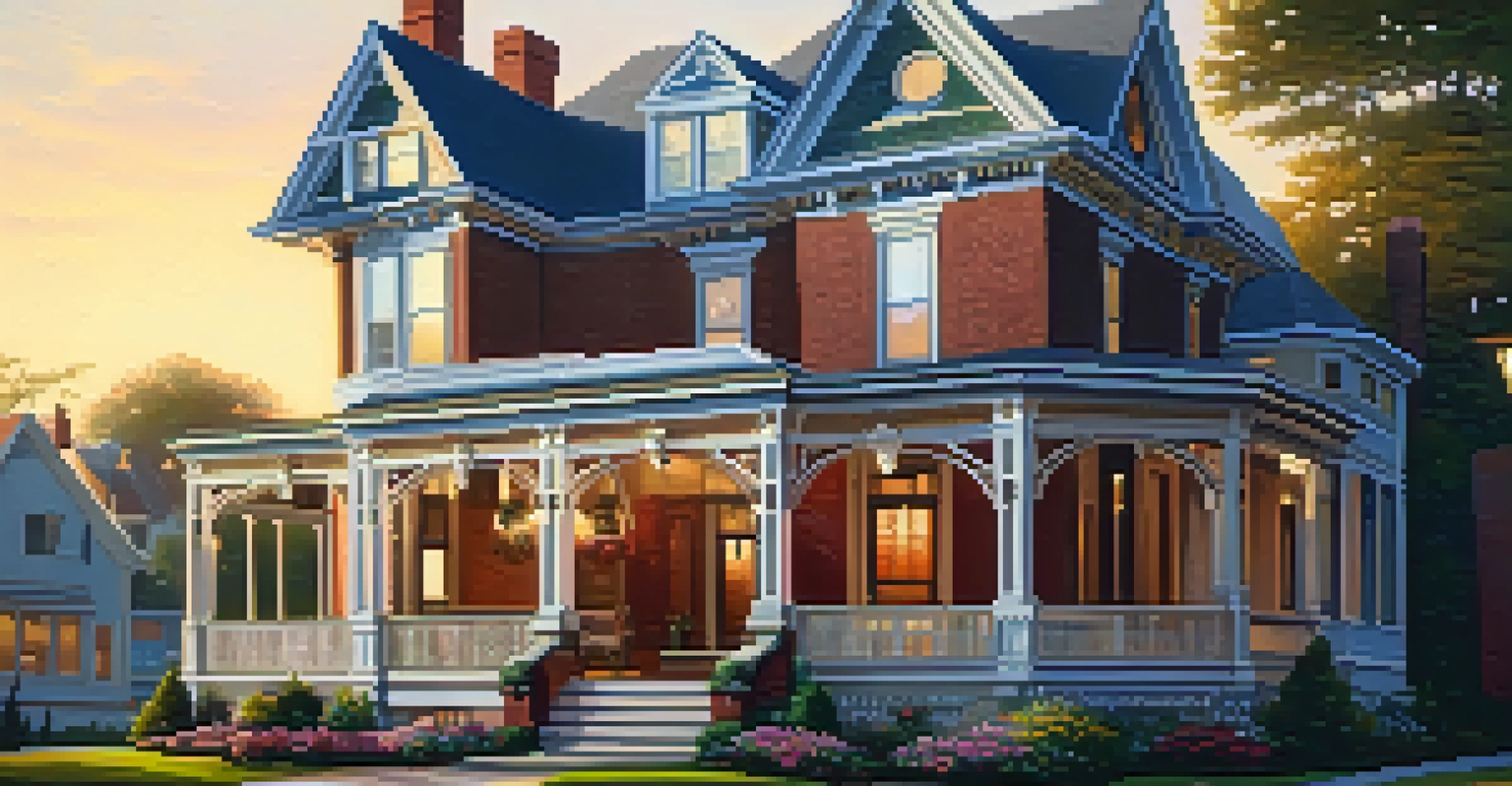Buffalo's Victorian Architecture: A Step Back in Time

A Glimpse into Buffalo's Architectural Heritage
Buffalo, New York, is a treasure trove of Victorian architecture, showcasing a vibrant past that reflects the city's rich history. From the mid-19th century to the early 20th century, this era marked a significant transformation in urban development, with Buffalo emerging as a bustling metropolis. The Victorian style, characterized by intricate details and diverse design elements, became a hallmark of the city's identity.
The architecture of a city is not just a reflection of its history, but also a testament to the dreams and aspirations of its people.
Walking through Buffalo, one can easily spot the ornate facades, steep gables, and decorative trim that define Victorian homes. Each building tells a story of its time, offering a glimpse into the lives of the families who once called them home. The architectural variety—from Queen Anne to Romanesque Revival—adds to the charm and allure of the city.
Exploring these neighborhoods feels like stepping back in time, where each corner reveals a new architectural gem. This unique blend of styles not only captivates visitors but also fosters a sense of pride among residents who cherish their city's heritage.
Key Characteristics of Victorian Architecture
Victorian architecture encompasses a range of styles, but they all share some common characteristics that make them easily recognizable. For instance, many buildings feature asymmetrical facades, intricate woodwork, and vibrant color palettes. These elements create a visual feast for the eyes, inviting admiration from both locals and tourists alike.

Another defining feature is the use of bay windows and expansive porches, which not only enhance the aesthetic appeal but also provide functional outdoor spaces. The attention to detail is astounding, with decorative brackets, ornate railings, and multi-gabled roofs adding layers of complexity to each structure. It’s as if each building is a canvas, showcasing the craftsmanship of its time.
Buffalo's Rich Architectural Heritage
Buffalo showcases an impressive collection of Victorian architecture that reflects its vibrant history and urban development.
Additionally, the use of various materials, such as brick, wood, and stone, adds to the richness of the architectural landscape. This diverse palette not only contributes to the unique character of each building but also reflects the economic conditions and artistic trends of the era.
Prominent Examples of Victorian Architecture in Buffalo
Buffalo boasts several iconic Victorian buildings that stand as testaments to the city's architectural prowess. One of the most notable examples is the Richardson Olmsted Complex, designed by the renowned architect H.H. Richardson. This stunning structure combines Romanesque and Victorian styles, creating a powerful presence that draws visitors from afar.
Preservation is a form of optimism, a belief that the best of our history can be carried forward into the future.
Another gem is the Martin House, designed by Frank Lloyd Wright, which showcases the Prairie School style influenced by Victorian design principles. Its innovative use of space and harmony with nature exemplifies Wright's vision while paying homage to the Victorian tradition. The house remains a highlight of Buffalo's architectural tour.
Don't forget about the variety of residential homes scattered throughout neighborhoods like Allentown and the Elmwood Village. Each street is lined with beautiful Victorian houses, reflecting the diverse styles and stories of the people who lived there. These neighborhoods are perfect for a leisurely stroll, allowing you to appreciate the unique details that make each home special.
The Role of Preservation in Buffalo's Victorian Legacy
Preserving Buffalo's Victorian architecture is crucial for maintaining the city's historical identity. Over the years, many organizations and community groups have dedicated themselves to restoring and protecting these architectural treasures. Their efforts ensure that future generations can appreciate the beauty and significance of these buildings.
Local preservation initiatives often involve working closely with homeowners to maintain the integrity of their properties. This collaboration not only helps protect the architectural style but also fosters a sense of community pride. When residents actively participate in preservation, they cultivate a deeper connection to their neighborhood's history.
Preservation Efforts Matter
Community initiatives play a crucial role in maintaining Buffalo's architectural legacy, ensuring future generations can appreciate these historical treasures.
Moreover, preservation efforts can also contribute to the local economy. By attracting tourists and architecture enthusiasts, these initiatives help promote Buffalo as a vibrant cultural destination. It’s a win-win situation where history and community come together to create a lasting impact.
The Influence of Victorian Architecture on Modern Design
Buffalo's Victorian architecture continues to inspire contemporary designers and architects, blending the old with the new. Many modern buildings incorporate elements reminiscent of Victorian style, such as intricate ornamentation and a focus on craftsmanship. This fusion of styles creates a unique architectural dialogue between the past and present.
For instance, new residential developments often draw on Victorian aesthetics, utilizing features like front porches and gabled roofs. Such designs not only pay homage to Buffalo’s architectural roots but also meet the needs of today's homeowners, creating spaces that feel both modern and timeless.
Additionally, local businesses are embracing Victorian elements in their branding and storefronts, further weaving the architectural heritage into the fabric of daily life. This interplay between history and modernity enriches the community, ensuring that Buffalo’s Victorian legacy continues to thrive.
Exploring Buffalo's Victorian Neighborhoods
To truly appreciate Buffalo's Victorian architecture, one must explore its historic neighborhoods. Areas like Allentown and the West Side are bursting with character, featuring streets lined with stunning homes and inviting shops. Each neighborhood has its own unique vibe, making it an adventure to stroll through and discover the various architectural styles.
As you wander, take note of the small details: the decorative trim, stained glass windows, and unique doorways. These elements contribute to the overall charm and authenticity of the neighborhoods, inviting you to imagine the lives lived within these walls. Local cafes and boutiques further enhance the experience, providing a perfect backdrop for a leisurely day out.
Victorian Influence in Modern Design
Contemporary designers in Buffalo are inspired by Victorian elements, creating a blend of old and new that enriches the city's architectural landscape.
Engaging with the community also adds to the experience. Many neighborhoods host events and tours that delve into the history of their architecture, offering a deeper understanding of the significance behind these beautiful homes. Embracing the local culture only enriches your visit, making it a memorable journey through time.
Visiting Buffalo: Tips for Exploring Victorian Architecture
If you're planning to explore Buffalo's Victorian architecture, there are a few tips to make the most of your visit. Start by researching neighborhoods known for their architectural significance, such as Allentown and the Elmwood Village. Creating an itinerary will help you prioritize the must-see sites while allowing for spontaneous discoveries along the way.
Consider joining a guided tour, which can offer valuable insights into the history and design elements of the buildings. Knowledgeable guides can share fascinating stories and anecdotes that bring the architecture to life, making your experience even more enriching. Plus, it's a great way to meet fellow architecture enthusiasts!

Lastly, don’t forget your camera! The stunning details and picturesque streets are perfect for capturing memories. Whether you’re an amateur photographer or simply want to document your adventures, the Victorian architecture of Buffalo provides endless opportunities for beautiful shots.